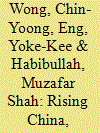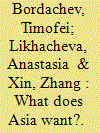| Srl | Item |
| 1 |
ID:
110113


|
|
|
|
|
| Publication |
2012.
|
| Summary/Abstract |
The Australian government as part of its aid programme allocates large funds to improve financial inclusion in developing countries. However, this does not take into account low educational levels in these countries. The existing literature on financial inclusion also treats the issue as mainly supply-centric and does not take cognisance of the fact that poor human development and high illiteracy levels in developing economies may prevent a large section of the population from benefitting from financial inclusion efforts, because of low awareness and comprehension of the financial services available. This study uses a detailed three-stage methodological approach to examine the relationship between financial development and human capital in 21 countries of developing Asia. The results show that a significant negative relationship exists between financial development proxied by M2/gdp and pupil:teacher ratios and a strong positive relationship exists between physical access to banks and expected years of schooling. Further, our financial development and educational development indices also show no clear pattern in the selected countries' financial and educational development.
|
|
|
|
|
|
|
|
|
|
|
|
|
|
|
|
| 2 |
ID:
130540


|
|
|
|
|
| Publication |
2014.
|
| Summary/Abstract |
Should Asia feel anxious about China's expansion? We look for the answer through the Bayesian estimation of a two-country New Keynesian model of production fragmentation covering ten Asian economies, including China. The estimates show that vis-à-vis China, the developed Asia has a more fragmented production structure with higher domestic value-added embodied in intermediates traded with China whereas the developing Asian production chains are equally if not less fragmented with more foreign value-added. We also find that China's expansion made possible by favorable demand and price shocks benefits all Asian neighbors. Expansion driven by total factor productivity improvement, however, lifts the aggregate value-added in the developing Asia but not in the developed Asia, unless the shocks symmetrically originate in both China and the developed Asia. Fixing the regional currencies irrevocably to the U.S. dollar amplifies the effect of China's productivity improvements, although it is nearly irrelevant for responses to other types of shocks. We conclude that production fragmentation and symmetry in shock are the keys to the answers of this question.
|
|
|
|
|
|
|
|
|
|
|
|
|
|
|
|
| 3 |
ID:
138218


|
|
|
|
|
| Summary/Abstract |
Over the years since the 1998 crisis, the so-called Emerging and Developing Asia has become a new engine of global economic growth. The region has been developing under the slogan "Asia for the world," and the world has been looking for opportunities that it could draw from the Asian economic miracle. Today we are witnessing a profound transformation of the existing model: almost all countries in the region are becoming more Asiacentric, and a new model is emerging that can be called "Asia for Asia." It seems to be a perfect time to ask: What does Asia want? And does this mean that Asian economies will be able to catch up with the best standards of quality that the local growing consumerist class is looking for?
|
|
|
|
|
|
|
|
|
|
|
|
|
|
|
|